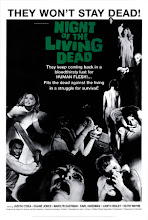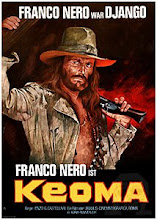
Cavalry Command
US/Philippines 1957 colour
aka Day Of The Trumpet, Cavalleria Commandos
Director/Writer Eddie Romero Producers Harry Smith, Cirio H. Santiago Associate Producer
Cast John Agar (Sgt. Judd Norcutt), Richard Arlen (Sgt. Jim Heisler), Pancho Magalona (Capt. Magno Maxalla), Alicia Vergel (Laura)
National Artist of the Philippines Eddie Romero had over twenty Tagalog-language films to his credit before he made Day Of The Trumpet, his first English language film for the export market, in 1957. It was produced by Cirio H. Santiago’s Premiere Productions with Eddie’s mentor and long-time collaborator Gerardo de Leon as co-producer, and with Gerardo’s brother Tito Arevalo providing the rousing orchestral score.
 Ostensibly a Filipino western, Day Of The Trumpet, or its
Ostensibly a Filipino western, Day Of The Trumpet, or its
 And so began what the Americans called an “insurrection” rather than a “war” that officially lasted for three years. It was during the American-Philippine War that the
And so began what the Americans called an “insurrection” rather than a “war” that officially lasted for three years. It was during the American-Philippine War that the
 Once you grasp the deep sense of outrage many Filipinos feel over this dark chapter of history, it makes Eddie Romero’s vision of life under the American occupation that much more curious. Set in Northern Luzon in the final clean-up phase of the uprising, the US Cavalry treks wearily into the small country town of
Once you grasp the deep sense of outrage many Filipinos feel over this dark chapter of history, it makes Eddie Romero’s vision of life under the American occupation that much more curious. Set in Northern Luzon in the final clean-up phase of the uprising, the US Cavalry treks wearily into the small country town of
 Of course there’s a clash of cultures, particularly amongst the restless male horse soldiers. The new teacher Haines finds his eye wandering towards an innocent convent lass, to the horror of the priest, who sees their differences as irreconcilable, and the Sergeant (John Agar from Brain From Planet Arous) is drawn to the fiery Laura, also the girlfriend of renegade patriot Magno. Once captured, Magno refuses to betray his ideals, and is painted as a bitter, dogmatic radical regarded by the Cavalry as a minor inconvenience. Brooding and almost drowning in resentment, he waits until fiesta time to draw together a pathetic ragtag brigade of revolutionaries to retake the town, with tragic consequences. Magno even turns on his child brother, a junior would-be guerrilla; even the child has learnt the Americans are not their enemies.
Of course there’s a clash of cultures, particularly amongst the restless male horse soldiers. The new teacher Haines finds his eye wandering towards an innocent convent lass, to the horror of the priest, who sees their differences as irreconcilable, and the Sergeant (John Agar from Brain From Planet Arous) is drawn to the fiery Laura, also the girlfriend of renegade patriot Magno. Once captured, Magno refuses to betray his ideals, and is painted as a bitter, dogmatic radical regarded by the Cavalry as a minor inconvenience. Brooding and almost drowning in resentment, he waits until fiesta time to draw together a pathetic ragtag brigade of revolutionaries to retake the town, with tragic consequences. Magno even turns on his child brother, a junior would-be guerrilla; even the child has learnt the Americans are not their enemies.
 Romero’s painstaking recreation of turn-of-the-century town and rural society shows he’s much more concerned with the human drama rather than the mechanics of war, and may explain why the film was not a success when finally released in the States in 1963 as Cavalry Command. For a film marketed as a western, with Magno as a parochial Pancho Villa, and the feather-wearing Igorots as ersatz Red Indians, it’s a cheat, and indeed the shoot ‘em up action doesn’t rear its white Stetson until three quarters through its running time. Instead it’s a serious meditation on the personal politics and consequences during occupation, one that shouldn’t take sides and yet does, for what one can only assume are for commercial reasons.
Romero’s painstaking recreation of turn-of-the-century town and rural society shows he’s much more concerned with the human drama rather than the mechanics of war, and may explain why the film was not a success when finally released in the States in 1963 as Cavalry Command. For a film marketed as a western, with Magno as a parochial Pancho Villa, and the feather-wearing Igorots as ersatz Red Indians, it’s a cheat, and indeed the shoot ‘em up action doesn’t rear its white Stetson until three quarters through its running time. Instead it’s a serious meditation on the personal politics and consequences during occupation, one that shouldn’t take sides and yet does, for what one can only assume are for commercial reasons.
aka Intramuros
Directors Gerardo de Leon, Eddie Romero Writers Cesar Amigo, Ferde Grofé Jr, “E.F.”/Eddie Romero Producer Eddie Romero Executive Producer Kane W. Lynn
Cast Jock Mahoney (Lt. Sorenson), Fernando Poe Jr (Nardo), Mike Parsons (Papa), Oscar Roncal (Joker)
The
 The Walls Of Hell is set in the final stages of the Battle of Manila, and filmed where it happened - behind the actual walled city of
The Walls Of Hell is set in the final stages of the Battle of Manila, and filmed where it happened - behind the actual walled city of
The Walls Of Hell is initially framed through the eyes of a visiting journalist intent on capturing the true spirit of
 The focus changes with the appearance of Nardo, a guerrilla from inside
The focus changes with the appearance of Nardo, a guerrilla from inside
 At first he’s suspected to be a spy working for the Japanese, but shows the soldiers a passageway to get in to – and for civilians get out of – Intramuros. The three hundred year old catacombs, now eerie smoke-shrouded sewers, are lit in a dramatic way to resemble the corridors of Hell. In fact the entire film appears to shake; the soundtrack of sparingly-used military snare over a ceaseless artillery barrage lends a very real sense of doom, as do the wobbling cameras and ever-present smoke and fires. Director Eddie Romero once said he WISHED Filipino filmmakers could work with a B-Grade budget, and I’m sure the film is much smaller than he would have liked, but by telescoping the action to tight, claustrophobic locations, the parts add together to make a vivid whole.
At first he’s suspected to be a spy working for the Japanese, but shows the soldiers a passageway to get in to – and for civilians get out of – Intramuros. The three hundred year old catacombs, now eerie smoke-shrouded sewers, are lit in a dramatic way to resemble the corridors of Hell. In fact the entire film appears to shake; the soundtrack of sparingly-used military snare over a ceaseless artillery barrage lends a very real sense of doom, as do the wobbling cameras and ever-present smoke and fires. Director Eddie Romero once said he WISHED Filipino filmmakers could work with a B-Grade budget, and I’m sure the film is much smaller than he would have liked, but by telescoping the action to tight, claustrophobic locations, the parts add together to make a vivid whole.
The Walls Of Hell lists two directors, both enshrined as National Artists of the Philippines, and marks a truly successful collaboration between the two directors: Eddie Romero, primarily a screenwriter before moving into directing, concentrates on the actors and the unfolding drama, while the older Gerardo de Leon is more interested in frame composition and the film’s gorgeous black and white aesthetics. Ferde Grofe Jr took time off from working on George Montgomery’s tropical action films to contribute to the script which was filmed simultaneously, as Romero often did under his “Filipinas Productions” banner, as a Tagalog-language version called Intramuros. Naturally in the
 It’s a gung-ho war film Filipino style by a primarily local cast and crew and with added, rather creepy sense of history by filming on the actual locations. I’m sure the Ghosts of Manila are watching as we fearlessly scale The Walls Of Hell.
It’s a gung-ho war film Filipino style by a primarily local cast and crew and with added, rather creepy sense of history by filming on the actual locations. I’m sure the Ghosts of Manila are watching as we fearlessly scale The Walls Of Hell.






















































































No comments:
Post a Comment